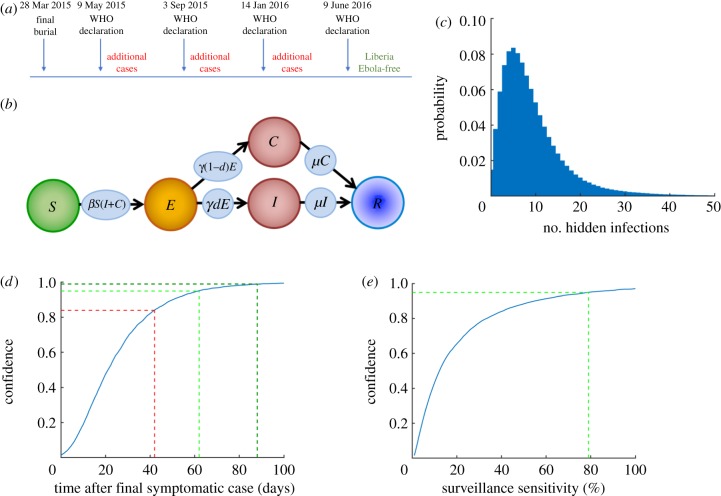Figure 1.
The confidence in end-of-outbreak declarations following the apparent end of an Ebola outbreak. (a) Schematic showing the sequence of events in Liberia at the end of the 2013–2016 Ebola epidemic, in which the outbreak was incorrectly declared over three times. (b) Schematic of the compartmental model used in our analyses. (c) The number of hidden cases (E or C) remaining in simulated Ebola outbreaks at the first timepoint at which the number of symptomatic cases (I) reaches zero. (d) The confidence in end-of-outbreak declarations (i.e. the probability that no undetected infections (E or C) remain in the population), for different time periods after removal of the ‘final’ symptomatic case (blue) at the ends of major outbreaks (outbreaks in which more than 20 individuals are ever infected). The current WHO guideline period of 42 days leads to a confidence of 0.84 that the outbreak is over (red), whereas periods of 62 or 88 days correspond to confidences of 0.95 (light green) and 0.99 (dark green), respectively. (e) The confidence in end-of-outbreak declarations made 42 days after removal of the ‘final’ symptomatic case, for different values of the surveillance sensitivity (blue). For an end-of-outbreak confidence of 0.95 after 42 days without symptomatic cases, a surveillance sensitivity of 79% is required (light green). The results in panels (c) and (d) were obtained using 10 000 simulations of the model, and the results in panel (e) were obtained using 10 000 simulations of the model for each possible value of the surveillance sensitivity.

